Challenges Faced by Disabled Children
VerifiedAdded on 2023/01/09
|14
|3894
|21
AI Summary
This essay discusses the challenges faced by disabled children, including community beliefs, limited involvement, education, inferiority complex, and poor health. It also explores current policies and advocacy efforts to support disabled children. The document type is an essay and the assignment type is a research paper.
Contribute Materials
Your contribution can guide someone’s learning journey. Share your
documents today.

Children With Disability1
Children with disability
Name
Institution
Date
Course
Tutor
City/Sate
Children with disability
Name
Institution
Date
Course
Tutor
City/Sate
Secure Best Marks with AI Grader
Need help grading? Try our AI Grader for instant feedback on your assignments.
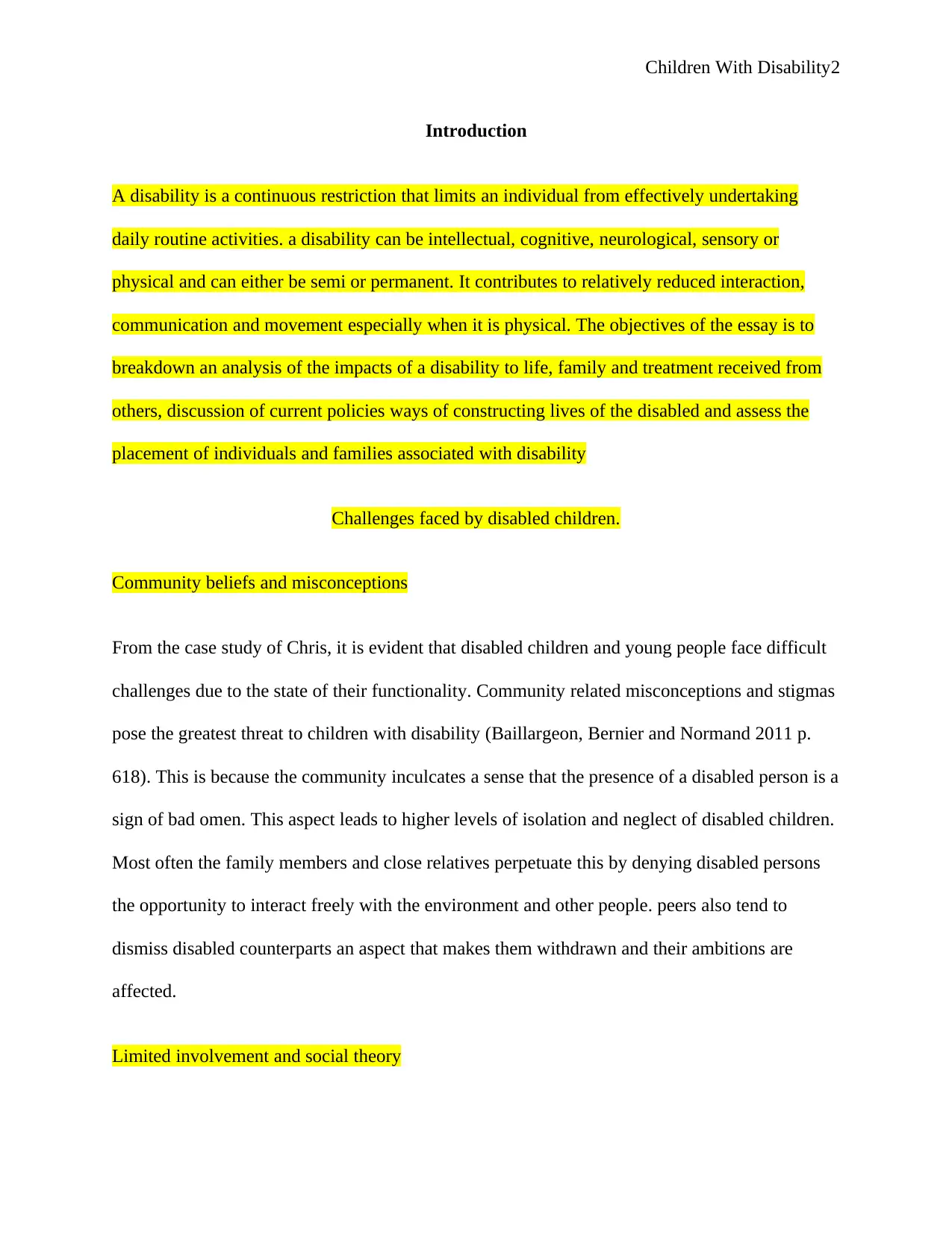
Children With Disability2
Introduction
A disability is a continuous restriction that limits an individual from effectively undertaking
daily routine activities. a disability can be intellectual, cognitive, neurological, sensory or
physical and can either be semi or permanent. It contributes to relatively reduced interaction,
communication and movement especially when it is physical. The objectives of the essay is to
breakdown an analysis of the impacts of a disability to life, family and treatment received from
others, discussion of current policies ways of constructing lives of the disabled and assess the
placement of individuals and families associated with disability
Challenges faced by disabled children.
Community beliefs and misconceptions
From the case study of Chris, it is evident that disabled children and young people face difficult
challenges due to the state of their functionality. Community related misconceptions and stigmas
pose the greatest threat to children with disability (Baillargeon, Bernier and Normand 2011 p.
618). This is because the community inculcates a sense that the presence of a disabled person is a
sign of bad omen. This aspect leads to higher levels of isolation and neglect of disabled children.
Most often the family members and close relatives perpetuate this by denying disabled persons
the opportunity to interact freely with the environment and other people. peers also tend to
dismiss disabled counterparts an aspect that makes them withdrawn and their ambitions are
affected.
Limited involvement and social theory
Introduction
A disability is a continuous restriction that limits an individual from effectively undertaking
daily routine activities. a disability can be intellectual, cognitive, neurological, sensory or
physical and can either be semi or permanent. It contributes to relatively reduced interaction,
communication and movement especially when it is physical. The objectives of the essay is to
breakdown an analysis of the impacts of a disability to life, family and treatment received from
others, discussion of current policies ways of constructing lives of the disabled and assess the
placement of individuals and families associated with disability
Challenges faced by disabled children.
Community beliefs and misconceptions
From the case study of Chris, it is evident that disabled children and young people face difficult
challenges due to the state of their functionality. Community related misconceptions and stigmas
pose the greatest threat to children with disability (Baillargeon, Bernier and Normand 2011 p.
618). This is because the community inculcates a sense that the presence of a disabled person is a
sign of bad omen. This aspect leads to higher levels of isolation and neglect of disabled children.
Most often the family members and close relatives perpetuate this by denying disabled persons
the opportunity to interact freely with the environment and other people. peers also tend to
dismiss disabled counterparts an aspect that makes them withdrawn and their ambitions are
affected.
Limited involvement and social theory
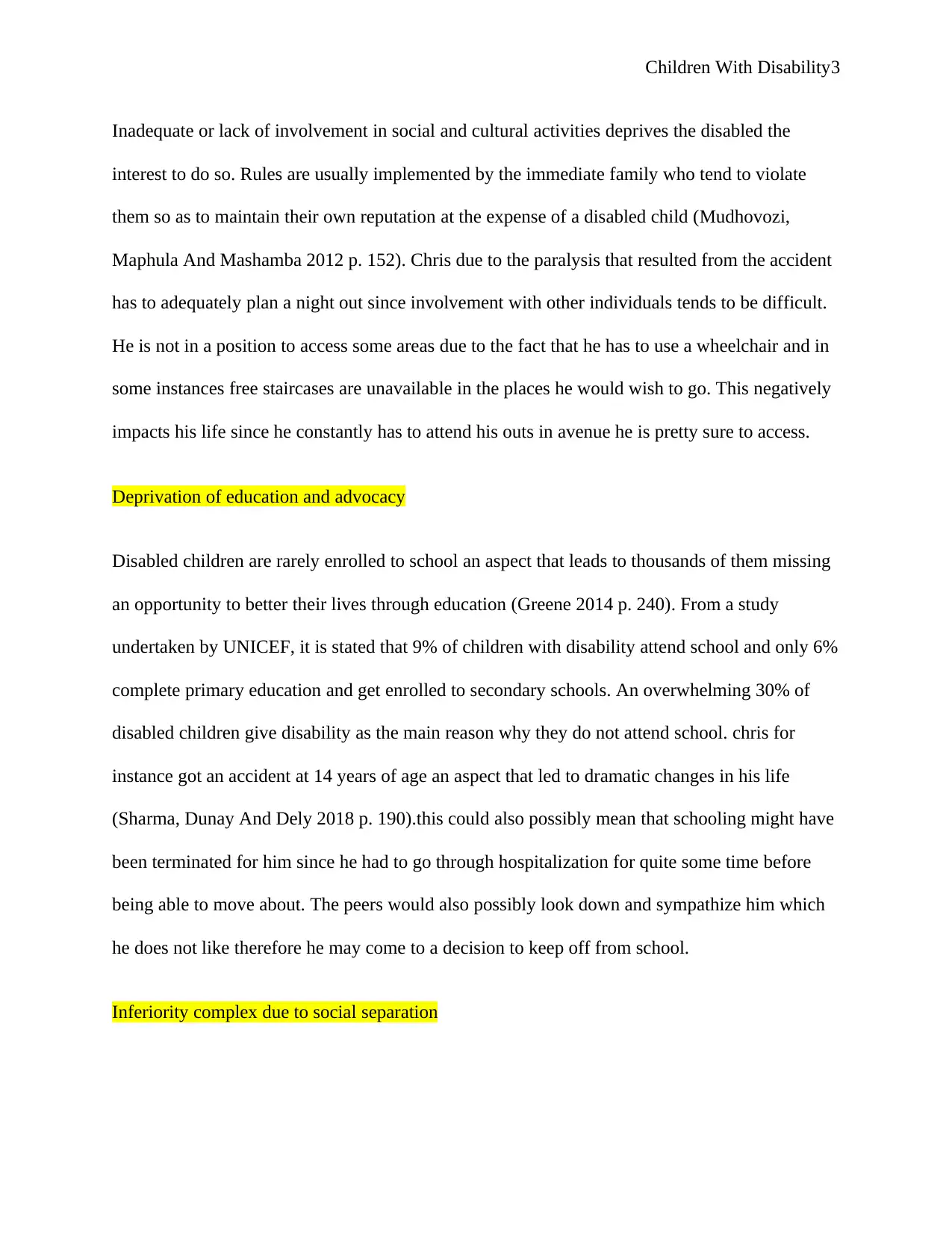
Children With Disability3
Inadequate or lack of involvement in social and cultural activities deprives the disabled the
interest to do so. Rules are usually implemented by the immediate family who tend to violate
them so as to maintain their own reputation at the expense of a disabled child (Mudhovozi,
Maphula And Mashamba 2012 p. 152). Chris due to the paralysis that resulted from the accident
has to adequately plan a night out since involvement with other individuals tends to be difficult.
He is not in a position to access some areas due to the fact that he has to use a wheelchair and in
some instances free staircases are unavailable in the places he would wish to go. This negatively
impacts his life since he constantly has to attend his outs in avenue he is pretty sure to access.
Deprivation of education and advocacy
Disabled children are rarely enrolled to school an aspect that leads to thousands of them missing
an opportunity to better their lives through education (Greene 2014 p. 240). From a study
undertaken by UNICEF, it is stated that 9% of children with disability attend school and only 6%
complete primary education and get enrolled to secondary schools. An overwhelming 30% of
disabled children give disability as the main reason why they do not attend school. chris for
instance got an accident at 14 years of age an aspect that led to dramatic changes in his life
(Sharma, Dunay And Dely 2018 p. 190).this could also possibly mean that schooling might have
been terminated for him since he had to go through hospitalization for quite some time before
being able to move about. The peers would also possibly look down and sympathize him which
he does not like therefore he may come to a decision to keep off from school.
Inferiority complex due to social separation
Inadequate or lack of involvement in social and cultural activities deprives the disabled the
interest to do so. Rules are usually implemented by the immediate family who tend to violate
them so as to maintain their own reputation at the expense of a disabled child (Mudhovozi,
Maphula And Mashamba 2012 p. 152). Chris due to the paralysis that resulted from the accident
has to adequately plan a night out since involvement with other individuals tends to be difficult.
He is not in a position to access some areas due to the fact that he has to use a wheelchair and in
some instances free staircases are unavailable in the places he would wish to go. This negatively
impacts his life since he constantly has to attend his outs in avenue he is pretty sure to access.
Deprivation of education and advocacy
Disabled children are rarely enrolled to school an aspect that leads to thousands of them missing
an opportunity to better their lives through education (Greene 2014 p. 240). From a study
undertaken by UNICEF, it is stated that 9% of children with disability attend school and only 6%
complete primary education and get enrolled to secondary schools. An overwhelming 30% of
disabled children give disability as the main reason why they do not attend school. chris for
instance got an accident at 14 years of age an aspect that led to dramatic changes in his life
(Sharma, Dunay And Dely 2018 p. 190).this could also possibly mean that schooling might have
been terminated for him since he had to go through hospitalization for quite some time before
being able to move about. The peers would also possibly look down and sympathize him which
he does not like therefore he may come to a decision to keep off from school.
Inferiority complex due to social separation
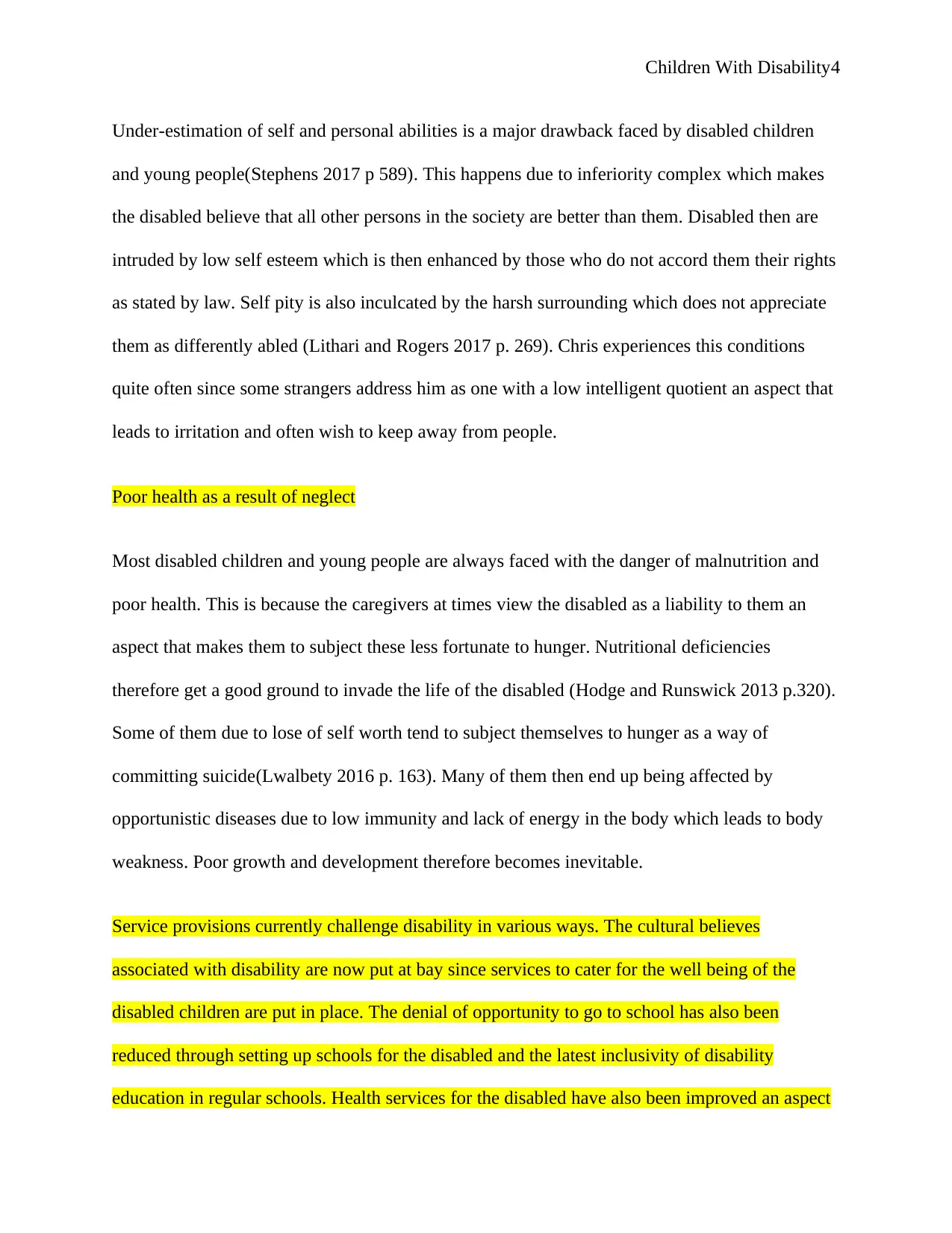
Children With Disability4
Under-estimation of self and personal abilities is a major drawback faced by disabled children
and young people(Stephens 2017 p 589). This happens due to inferiority complex which makes
the disabled believe that all other persons in the society are better than them. Disabled then are
intruded by low self esteem which is then enhanced by those who do not accord them their rights
as stated by law. Self pity is also inculcated by the harsh surrounding which does not appreciate
them as differently abled (Lithari and Rogers 2017 p. 269). Chris experiences this conditions
quite often since some strangers address him as one with a low intelligent quotient an aspect that
leads to irritation and often wish to keep away from people.
Poor health as a result of neglect
Most disabled children and young people are always faced with the danger of malnutrition and
poor health. This is because the caregivers at times view the disabled as a liability to them an
aspect that makes them to subject these less fortunate to hunger. Nutritional deficiencies
therefore get a good ground to invade the life of the disabled (Hodge and Runswick 2013 p.320).
Some of them due to lose of self worth tend to subject themselves to hunger as a way of
committing suicide(Lwalbety 2016 p. 163). Many of them then end up being affected by
opportunistic diseases due to low immunity and lack of energy in the body which leads to body
weakness. Poor growth and development therefore becomes inevitable.
Service provisions currently challenge disability in various ways. The cultural believes
associated with disability are now put at bay since services to cater for the well being of the
disabled children are put in place. The denial of opportunity to go to school has also been
reduced through setting up schools for the disabled and the latest inclusivity of disability
education in regular schools. Health services for the disabled have also been improved an aspect
Under-estimation of self and personal abilities is a major drawback faced by disabled children
and young people(Stephens 2017 p 589). This happens due to inferiority complex which makes
the disabled believe that all other persons in the society are better than them. Disabled then are
intruded by low self esteem which is then enhanced by those who do not accord them their rights
as stated by law. Self pity is also inculcated by the harsh surrounding which does not appreciate
them as differently abled (Lithari and Rogers 2017 p. 269). Chris experiences this conditions
quite often since some strangers address him as one with a low intelligent quotient an aspect that
leads to irritation and often wish to keep away from people.
Poor health as a result of neglect
Most disabled children and young people are always faced with the danger of malnutrition and
poor health. This is because the caregivers at times view the disabled as a liability to them an
aspect that makes them to subject these less fortunate to hunger. Nutritional deficiencies
therefore get a good ground to invade the life of the disabled (Hodge and Runswick 2013 p.320).
Some of them due to lose of self worth tend to subject themselves to hunger as a way of
committing suicide(Lwalbety 2016 p. 163). Many of them then end up being affected by
opportunistic diseases due to low immunity and lack of energy in the body which leads to body
weakness. Poor growth and development therefore becomes inevitable.
Service provisions currently challenge disability in various ways. The cultural believes
associated with disability are now put at bay since services to cater for the well being of the
disabled children are put in place. The denial of opportunity to go to school has also been
reduced through setting up schools for the disabled and the latest inclusivity of disability
education in regular schools. Health services for the disabled have also been improved an aspect
Secure Best Marks with AI Grader
Need help grading? Try our AI Grader for instant feedback on your assignments.
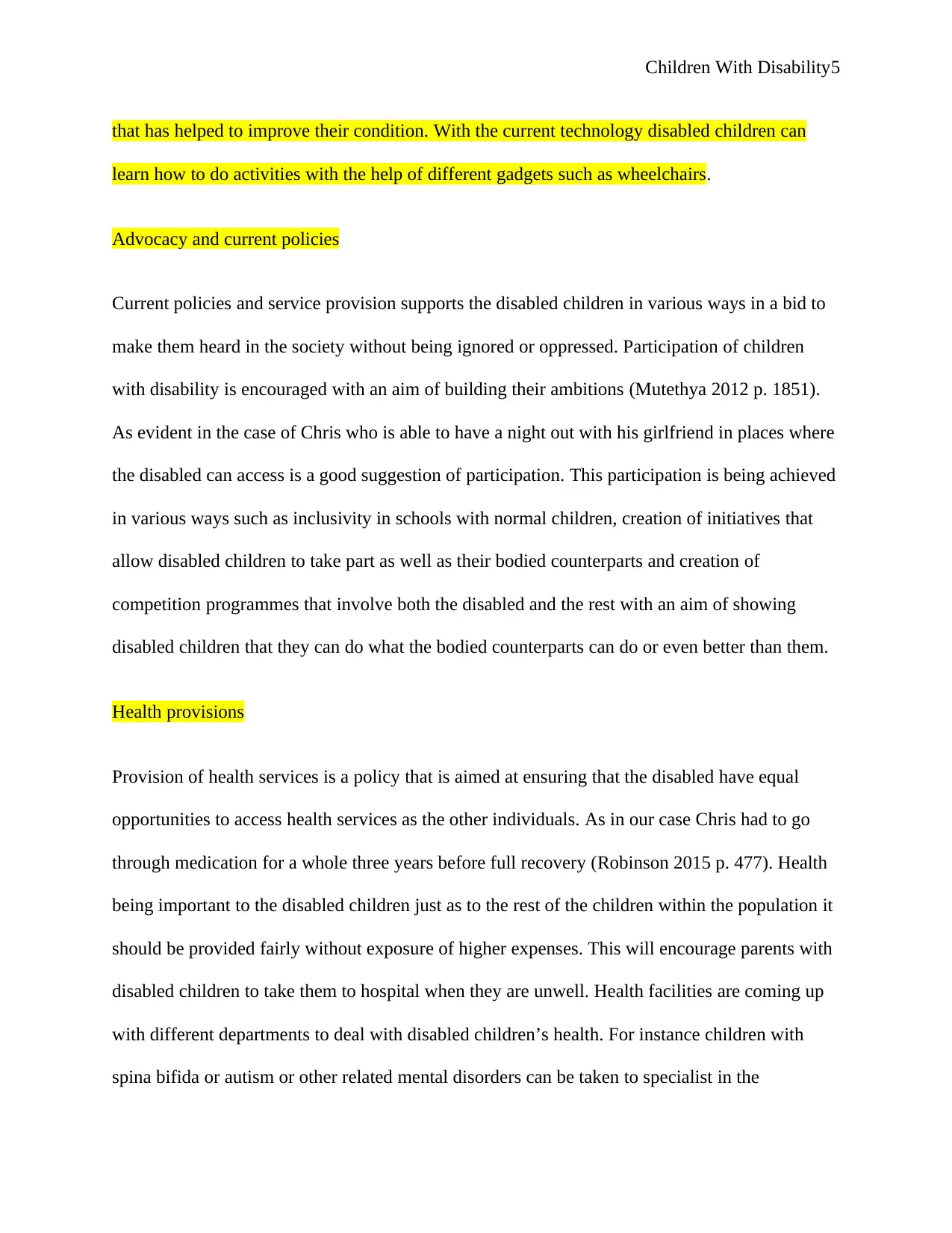
Children With Disability5
that has helped to improve their condition. With the current technology disabled children can
learn how to do activities with the help of different gadgets such as wheelchairs.
Advocacy and current policies
Current policies and service provision supports the disabled children in various ways in a bid to
make them heard in the society without being ignored or oppressed. Participation of children
with disability is encouraged with an aim of building their ambitions (Mutethya 2012 p. 1851).
As evident in the case of Chris who is able to have a night out with his girlfriend in places where
the disabled can access is a good suggestion of participation. This participation is being achieved
in various ways such as inclusivity in schools with normal children, creation of initiatives that
allow disabled children to take part as well as their bodied counterparts and creation of
competition programmes that involve both the disabled and the rest with an aim of showing
disabled children that they can do what the bodied counterparts can do or even better than them.
Health provisions
Provision of health services is a policy that is aimed at ensuring that the disabled have equal
opportunities to access health services as the other individuals. As in our case Chris had to go
through medication for a whole three years before full recovery (Robinson 2015 p. 477). Health
being important to the disabled children just as to the rest of the children within the population it
should be provided fairly without exposure of higher expenses. This will encourage parents with
disabled children to take them to hospital when they are unwell. Health facilities are coming up
with different departments to deal with disabled children’s health. For instance children with
spina bifida or autism or other related mental disorders can be taken to specialist in the
that has helped to improve their condition. With the current technology disabled children can
learn how to do activities with the help of different gadgets such as wheelchairs.
Advocacy and current policies
Current policies and service provision supports the disabled children in various ways in a bid to
make them heard in the society without being ignored or oppressed. Participation of children
with disability is encouraged with an aim of building their ambitions (Mutethya 2012 p. 1851).
As evident in the case of Chris who is able to have a night out with his girlfriend in places where
the disabled can access is a good suggestion of participation. This participation is being achieved
in various ways such as inclusivity in schools with normal children, creation of initiatives that
allow disabled children to take part as well as their bodied counterparts and creation of
competition programmes that involve both the disabled and the rest with an aim of showing
disabled children that they can do what the bodied counterparts can do or even better than them.
Health provisions
Provision of health services is a policy that is aimed at ensuring that the disabled have equal
opportunities to access health services as the other individuals. As in our case Chris had to go
through medication for a whole three years before full recovery (Robinson 2015 p. 477). Health
being important to the disabled children just as to the rest of the children within the population it
should be provided fairly without exposure of higher expenses. This will encourage parents with
disabled children to take them to hospital when they are unwell. Health facilities are coming up
with different departments to deal with disabled children’s health. For instance children with
spina bifida or autism or other related mental disorders can be taken to specialist in the
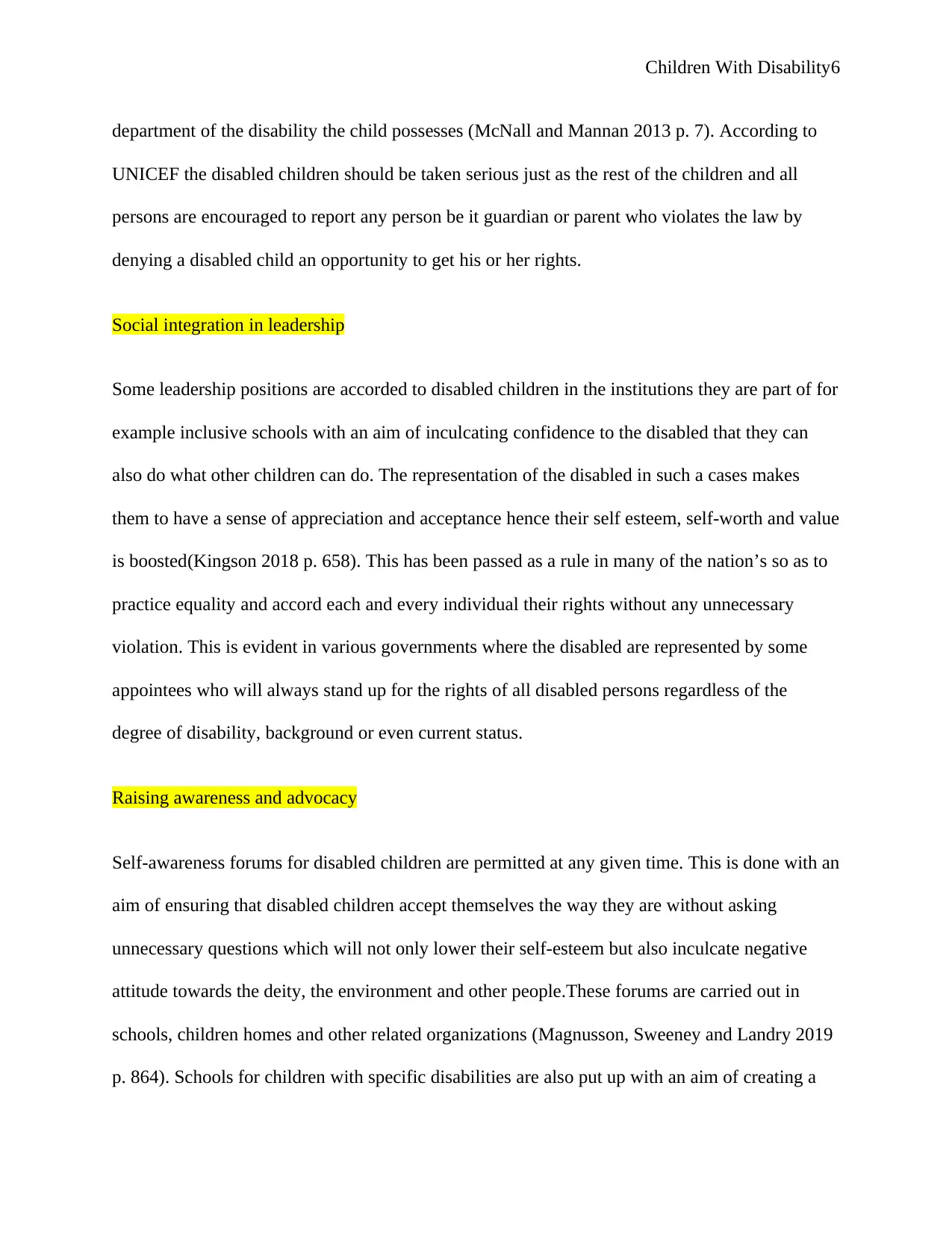
Children With Disability6
department of the disability the child possesses (McNall and Mannan 2013 p. 7). According to
UNICEF the disabled children should be taken serious just as the rest of the children and all
persons are encouraged to report any person be it guardian or parent who violates the law by
denying a disabled child an opportunity to get his or her rights.
Social integration in leadership
Some leadership positions are accorded to disabled children in the institutions they are part of for
example inclusive schools with an aim of inculcating confidence to the disabled that they can
also do what other children can do. The representation of the disabled in such a cases makes
them to have a sense of appreciation and acceptance hence their self esteem, self-worth and value
is boosted(Kingson 2018 p. 658). This has been passed as a rule in many of the nation’s so as to
practice equality and accord each and every individual their rights without any unnecessary
violation. This is evident in various governments where the disabled are represented by some
appointees who will always stand up for the rights of all disabled persons regardless of the
degree of disability, background or even current status.
Raising awareness and advocacy
Self-awareness forums for disabled children are permitted at any given time. This is done with an
aim of ensuring that disabled children accept themselves the way they are without asking
unnecessary questions which will not only lower their self-esteem but also inculcate negative
attitude towards the deity, the environment and other people.These forums are carried out in
schools, children homes and other related organizations (Magnusson, Sweeney and Landry 2019
p. 864). Schools for children with specific disabilities are also put up with an aim of creating a
department of the disability the child possesses (McNall and Mannan 2013 p. 7). According to
UNICEF the disabled children should be taken serious just as the rest of the children and all
persons are encouraged to report any person be it guardian or parent who violates the law by
denying a disabled child an opportunity to get his or her rights.
Social integration in leadership
Some leadership positions are accorded to disabled children in the institutions they are part of for
example inclusive schools with an aim of inculcating confidence to the disabled that they can
also do what other children can do. The representation of the disabled in such a cases makes
them to have a sense of appreciation and acceptance hence their self esteem, self-worth and value
is boosted(Kingson 2018 p. 658). This has been passed as a rule in many of the nation’s so as to
practice equality and accord each and every individual their rights without any unnecessary
violation. This is evident in various governments where the disabled are represented by some
appointees who will always stand up for the rights of all disabled persons regardless of the
degree of disability, background or even current status.
Raising awareness and advocacy
Self-awareness forums for disabled children are permitted at any given time. This is done with an
aim of ensuring that disabled children accept themselves the way they are without asking
unnecessary questions which will not only lower their self-esteem but also inculcate negative
attitude towards the deity, the environment and other people.These forums are carried out in
schools, children homes and other related organizations (Magnusson, Sweeney and Landry 2019
p. 864). Schools for children with specific disabilities are also put up with an aim of creating a

Children With Disability7
suitable environment where the children with the same difficulty get an opportunity to interact
with each other hence able to cope with the challenges they go through as a group and not as
single individuals(Fisher and Shang 2014 p.566). This helps them to appreciate each other as
unique and with different ability from what the environment inculcates into their minds. Co-
operation, responsibility and love is fostered in this setting since the disabled children have to
cooperate in undertaking some duties e.g. cleaning and other arrangements. It is in these forums
that disabled children are educated on their rights to as to minimize chances of being exploited
unaware.
Child rights
The disabled children are also featured in the protection laws. This is where each and all details
concerned with disabled children protection are outlined with clarity (Seo Hee Lee 2018 p. 26).
This helps to ensure that all the people can read and understand the guidelines so as to report any
violation of the rules protecting the disabled children. Through the media all the individuals of
the society are encouraged to take part in protecting the disabled. Exploitation and misuse of
disabled children has then been reduced because all people are custodians of these laws which
are protecting these children (Resch 2010 p. 142). The disabled children are also actively
educated on these rights which are protecting an aspect that has made a majority of them to be
able to stand up and fight for their own wellbeing. These laws have brought about a significant
decrease of abuse to the disabled children over the years.
States role in advocacy
suitable environment where the children with the same difficulty get an opportunity to interact
with each other hence able to cope with the challenges they go through as a group and not as
single individuals(Fisher and Shang 2014 p.566). This helps them to appreciate each other as
unique and with different ability from what the environment inculcates into their minds. Co-
operation, responsibility and love is fostered in this setting since the disabled children have to
cooperate in undertaking some duties e.g. cleaning and other arrangements. It is in these forums
that disabled children are educated on their rights to as to minimize chances of being exploited
unaware.
Child rights
The disabled children are also featured in the protection laws. This is where each and all details
concerned with disabled children protection are outlined with clarity (Seo Hee Lee 2018 p. 26).
This helps to ensure that all the people can read and understand the guidelines so as to report any
violation of the rules protecting the disabled children. Through the media all the individuals of
the society are encouraged to take part in protecting the disabled. Exploitation and misuse of
disabled children has then been reduced because all people are custodians of these laws which
are protecting these children (Resch 2010 p. 142). The disabled children are also actively
educated on these rights which are protecting an aspect that has made a majority of them to be
able to stand up and fight for their own wellbeing. These laws have brought about a significant
decrease of abuse to the disabled children over the years.
States role in advocacy
Paraphrase This Document
Need a fresh take? Get an instant paraphrase of this document with our AI Paraphraser
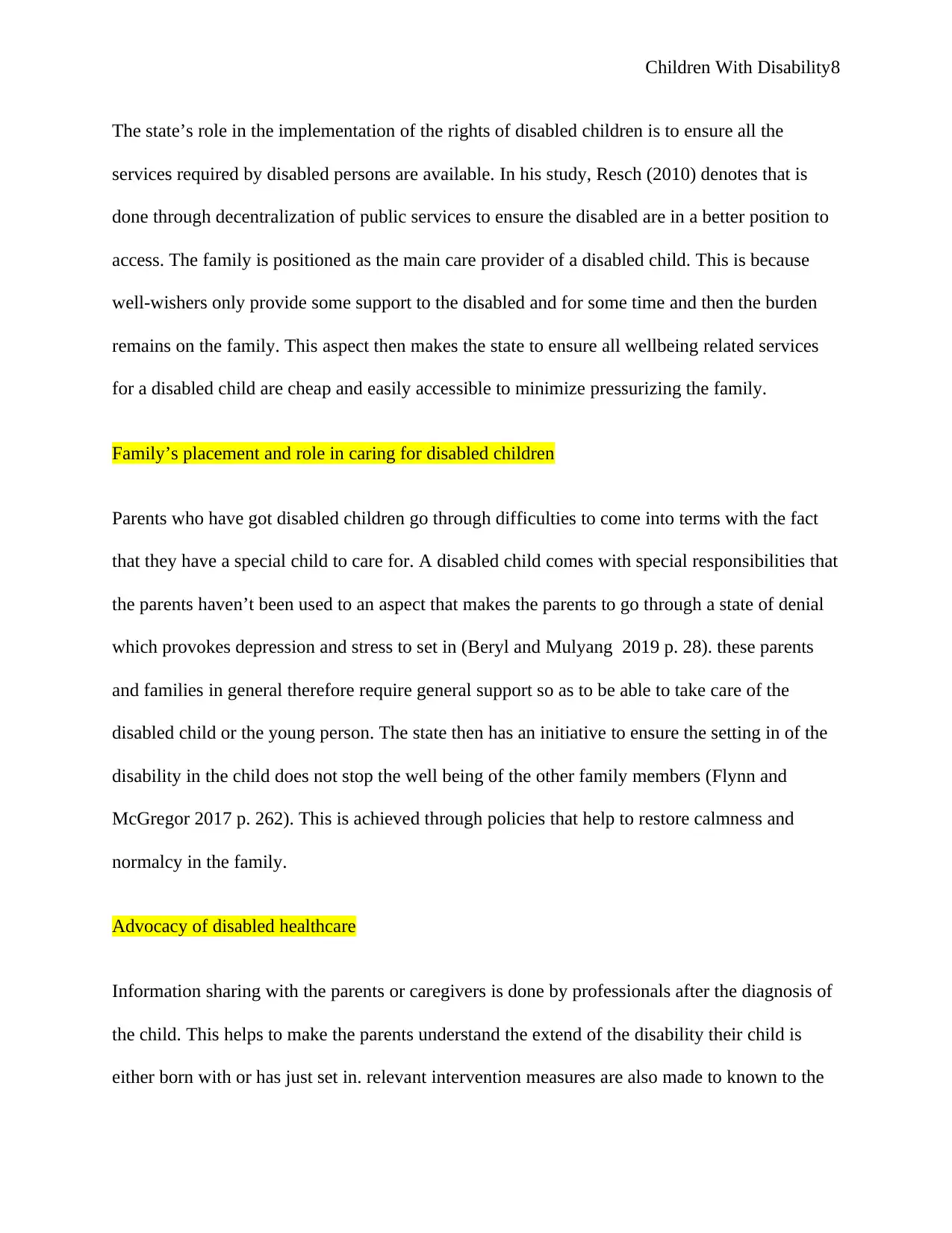
Children With Disability8
The state’s role in the implementation of the rights of disabled children is to ensure all the
services required by disabled persons are available. In his study, Resch (2010) denotes that is
done through decentralization of public services to ensure the disabled are in a better position to
access. The family is positioned as the main care provider of a disabled child. This is because
well-wishers only provide some support to the disabled and for some time and then the burden
remains on the family. This aspect then makes the state to ensure all wellbeing related services
for a disabled child are cheap and easily accessible to minimize pressurizing the family.
Family’s placement and role in caring for disabled children
Parents who have got disabled children go through difficulties to come into terms with the fact
that they have a special child to care for. A disabled child comes with special responsibilities that
the parents haven’t been used to an aspect that makes the parents to go through a state of denial
which provokes depression and stress to set in (Beryl and Mulyang 2019 p. 28). these parents
and families in general therefore require general support so as to be able to take care of the
disabled child or the young person. The state then has an initiative to ensure the setting in of the
disability in the child does not stop the well being of the other family members (Flynn and
McGregor 2017 p. 262). This is achieved through policies that help to restore calmness and
normalcy in the family.
Advocacy of disabled healthcare
Information sharing with the parents or caregivers is done by professionals after the diagnosis of
the child. This helps to make the parents understand the extend of the disability their child is
either born with or has just set in. relevant intervention measures are also made to known to the
The state’s role in the implementation of the rights of disabled children is to ensure all the
services required by disabled persons are available. In his study, Resch (2010) denotes that is
done through decentralization of public services to ensure the disabled are in a better position to
access. The family is positioned as the main care provider of a disabled child. This is because
well-wishers only provide some support to the disabled and for some time and then the burden
remains on the family. This aspect then makes the state to ensure all wellbeing related services
for a disabled child are cheap and easily accessible to minimize pressurizing the family.
Family’s placement and role in caring for disabled children
Parents who have got disabled children go through difficulties to come into terms with the fact
that they have a special child to care for. A disabled child comes with special responsibilities that
the parents haven’t been used to an aspect that makes the parents to go through a state of denial
which provokes depression and stress to set in (Beryl and Mulyang 2019 p. 28). these parents
and families in general therefore require general support so as to be able to take care of the
disabled child or the young person. The state then has an initiative to ensure the setting in of the
disability in the child does not stop the well being of the other family members (Flynn and
McGregor 2017 p. 262). This is achieved through policies that help to restore calmness and
normalcy in the family.
Advocacy of disabled healthcare
Information sharing with the parents or caregivers is done by professionals after the diagnosis of
the child. This helps to make the parents understand the extend of the disability their child is
either born with or has just set in. relevant intervention measures are also made to known to the
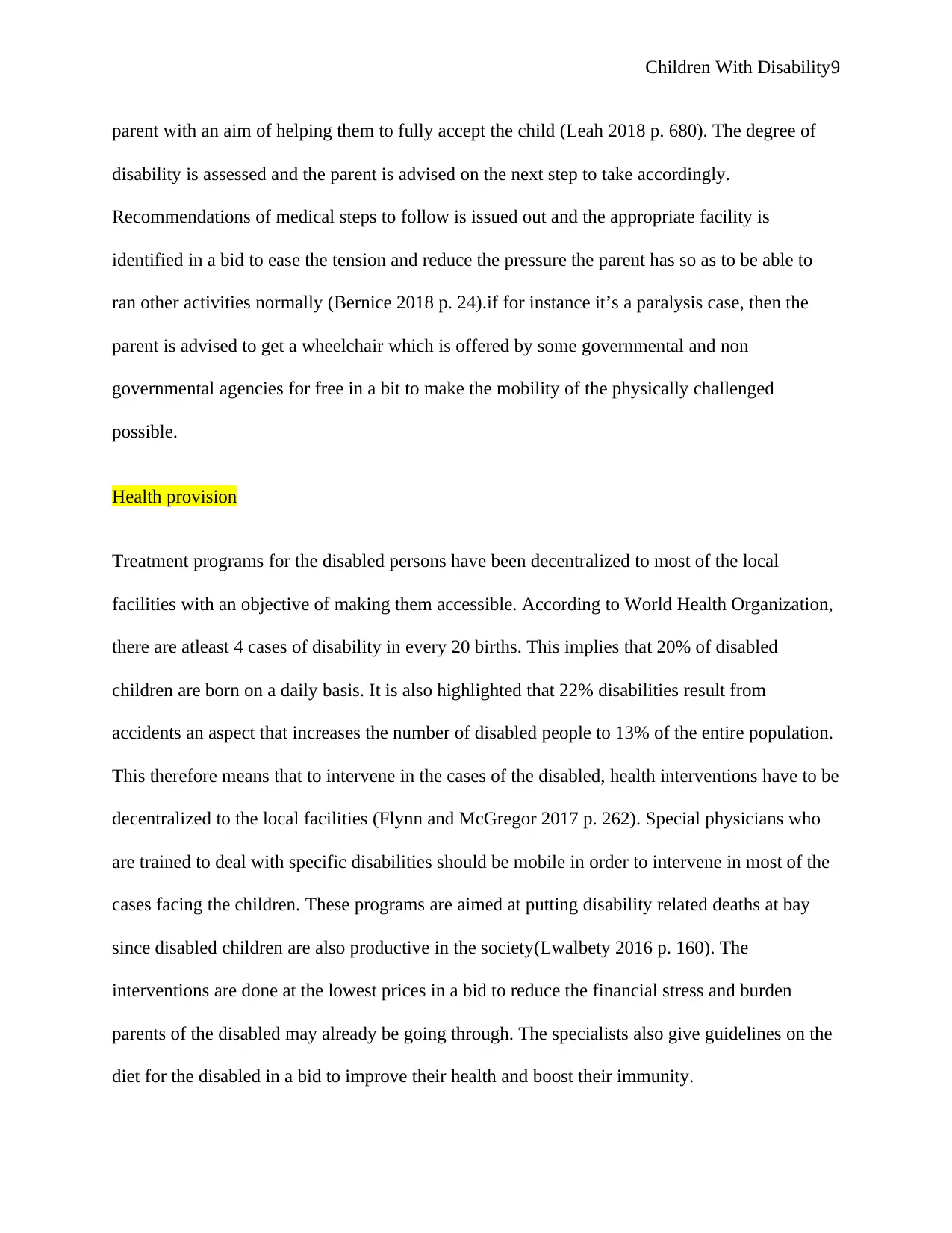
Children With Disability9
parent with an aim of helping them to fully accept the child (Leah 2018 p. 680). The degree of
disability is assessed and the parent is advised on the next step to take accordingly.
Recommendations of medical steps to follow is issued out and the appropriate facility is
identified in a bid to ease the tension and reduce the pressure the parent has so as to be able to
ran other activities normally (Bernice 2018 p. 24).if for instance it’s a paralysis case, then the
parent is advised to get a wheelchair which is offered by some governmental and non
governmental agencies for free in a bit to make the mobility of the physically challenged
possible.
Health provision
Treatment programs for the disabled persons have been decentralized to most of the local
facilities with an objective of making them accessible. According to World Health Organization,
there are atleast 4 cases of disability in every 20 births. This implies that 20% of disabled
children are born on a daily basis. It is also highlighted that 22% disabilities result from
accidents an aspect that increases the number of disabled people to 13% of the entire population.
This therefore means that to intervene in the cases of the disabled, health interventions have to be
decentralized to the local facilities (Flynn and McGregor 2017 p. 262). Special physicians who
are trained to deal with specific disabilities should be mobile in order to intervene in most of the
cases facing the children. These programs are aimed at putting disability related deaths at bay
since disabled children are also productive in the society(Lwalbety 2016 p. 160). The
interventions are done at the lowest prices in a bid to reduce the financial stress and burden
parents of the disabled may already be going through. The specialists also give guidelines on the
diet for the disabled in a bid to improve their health and boost their immunity.
parent with an aim of helping them to fully accept the child (Leah 2018 p. 680). The degree of
disability is assessed and the parent is advised on the next step to take accordingly.
Recommendations of medical steps to follow is issued out and the appropriate facility is
identified in a bid to ease the tension and reduce the pressure the parent has so as to be able to
ran other activities normally (Bernice 2018 p. 24).if for instance it’s a paralysis case, then the
parent is advised to get a wheelchair which is offered by some governmental and non
governmental agencies for free in a bit to make the mobility of the physically challenged
possible.
Health provision
Treatment programs for the disabled persons have been decentralized to most of the local
facilities with an objective of making them accessible. According to World Health Organization,
there are atleast 4 cases of disability in every 20 births. This implies that 20% of disabled
children are born on a daily basis. It is also highlighted that 22% disabilities result from
accidents an aspect that increases the number of disabled people to 13% of the entire population.
This therefore means that to intervene in the cases of the disabled, health interventions have to be
decentralized to the local facilities (Flynn and McGregor 2017 p. 262). Special physicians who
are trained to deal with specific disabilities should be mobile in order to intervene in most of the
cases facing the children. These programs are aimed at putting disability related deaths at bay
since disabled children are also productive in the society(Lwalbety 2016 p. 160). The
interventions are done at the lowest prices in a bid to reduce the financial stress and burden
parents of the disabled may already be going through. The specialists also give guidelines on the
diet for the disabled in a bid to improve their health and boost their immunity.
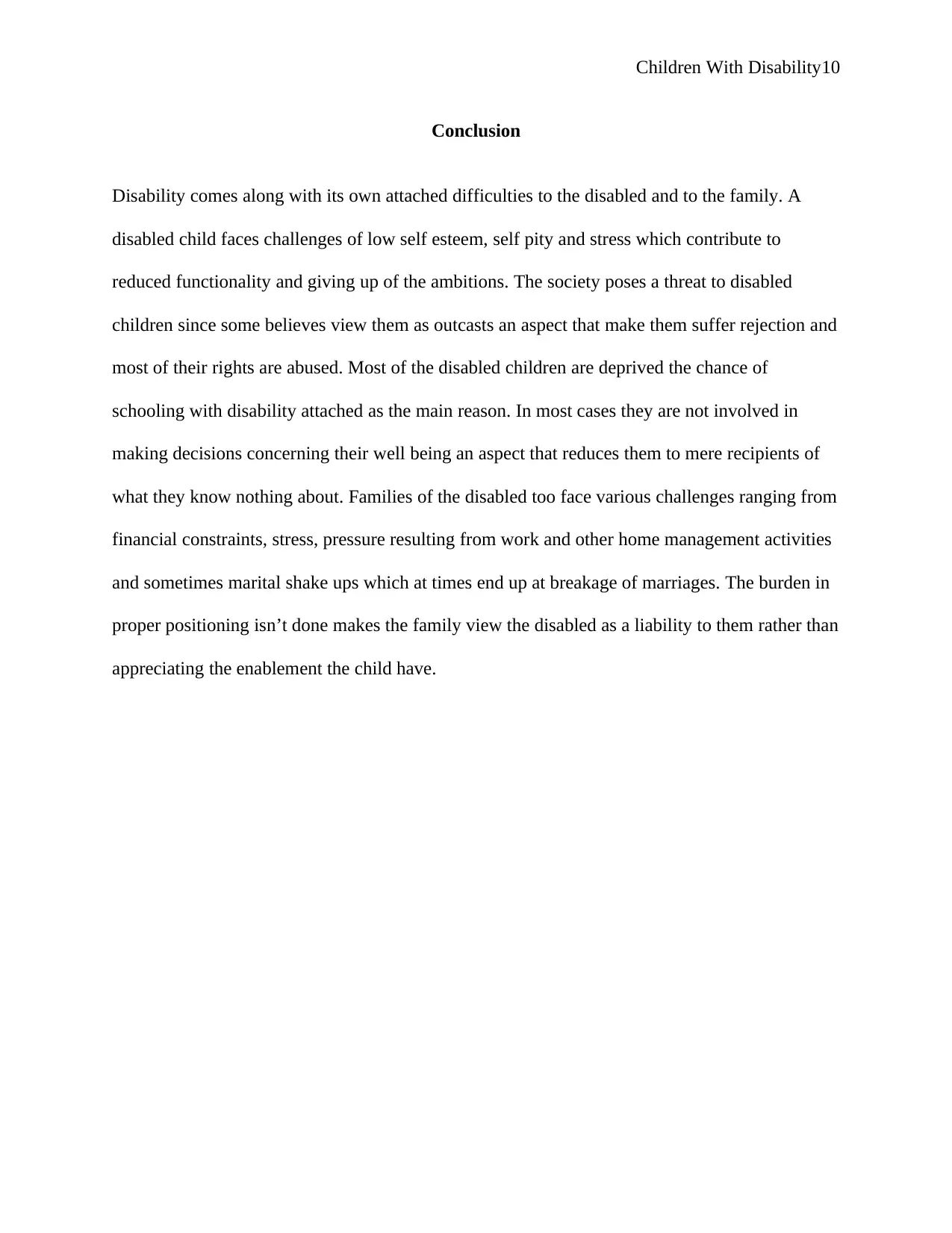
Children With Disability10
Conclusion
Disability comes along with its own attached difficulties to the disabled and to the family. A
disabled child faces challenges of low self esteem, self pity and stress which contribute to
reduced functionality and giving up of the ambitions. The society poses a threat to disabled
children since some believes view them as outcasts an aspect that make them suffer rejection and
most of their rights are abused. Most of the disabled children are deprived the chance of
schooling with disability attached as the main reason. In most cases they are not involved in
making decisions concerning their well being an aspect that reduces them to mere recipients of
what they know nothing about. Families of the disabled too face various challenges ranging from
financial constraints, stress, pressure resulting from work and other home management activities
and sometimes marital shake ups which at times end up at breakage of marriages. The burden in
proper positioning isn’t done makes the family view the disabled as a liability to them rather than
appreciating the enablement the child have.
Conclusion
Disability comes along with its own attached difficulties to the disabled and to the family. A
disabled child faces challenges of low self esteem, self pity and stress which contribute to
reduced functionality and giving up of the ambitions. The society poses a threat to disabled
children since some believes view them as outcasts an aspect that make them suffer rejection and
most of their rights are abused. Most of the disabled children are deprived the chance of
schooling with disability attached as the main reason. In most cases they are not involved in
making decisions concerning their well being an aspect that reduces them to mere recipients of
what they know nothing about. Families of the disabled too face various challenges ranging from
financial constraints, stress, pressure resulting from work and other home management activities
and sometimes marital shake ups which at times end up at breakage of marriages. The burden in
proper positioning isn’t done makes the family view the disabled as a liability to them rather than
appreciating the enablement the child have.
Secure Best Marks with AI Grader
Need help grading? Try our AI Grader for instant feedback on your assignments.
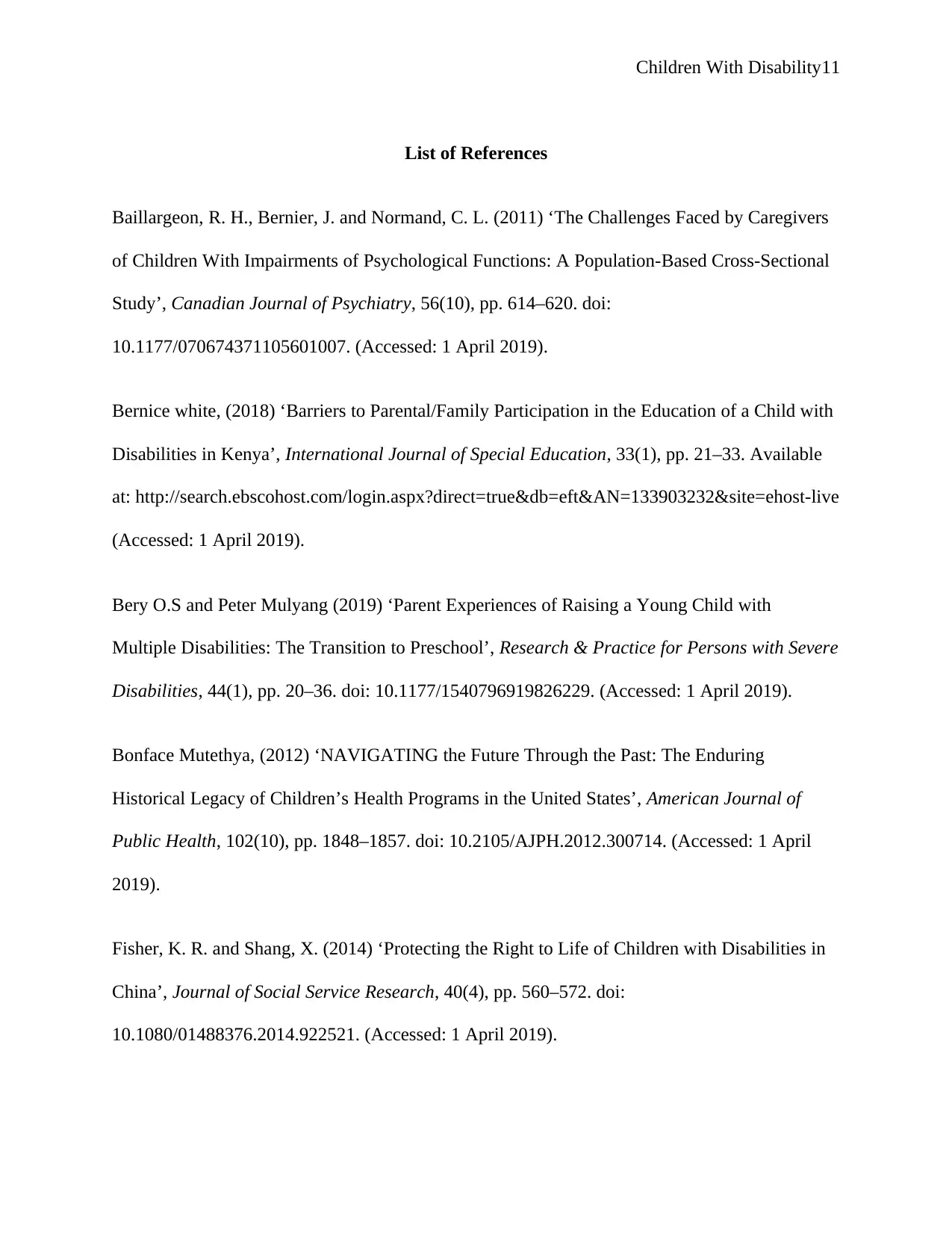
Children With Disability11
List of References
Baillargeon, R. H., Bernier, J. and Normand, C. L. (2011) ‘The Challenges Faced by Caregivers
of Children With Impairments of Psychological Functions: A Population-Based Cross-Sectional
Study’, Canadian Journal of Psychiatry, 56(10), pp. 614–620. doi:
10.1177/070674371105601007. (Accessed: 1 April 2019).
Bernice white, (2018) ‘Barriers to Parental/Family Participation in the Education of a Child with
Disabilities in Kenya’, International Journal of Special Education, 33(1), pp. 21–33. Available
at: http://search.ebscohost.com/login.aspx?direct=true&db=eft&AN=133903232&site=ehost-live
(Accessed: 1 April 2019).
Bery O.S and Peter Mulyang (2019) ‘Parent Experiences of Raising a Young Child with
Multiple Disabilities: The Transition to Preschool’, Research & Practice for Persons with Severe
Disabilities, 44(1), pp. 20–36. doi: 10.1177/1540796919826229. (Accessed: 1 April 2019).
Bonface Mutethya, (2012) ‘NAVIGATING the Future Through the Past: The Enduring
Historical Legacy of Children’s Health Programs in the United States’, American Journal of
Public Health, 102(10), pp. 1848–1857. doi: 10.2105/AJPH.2012.300714. (Accessed: 1 April
2019).
Fisher, K. R. and Shang, X. (2014) ‘Protecting the Right to Life of Children with Disabilities in
China’, Journal of Social Service Research, 40(4), pp. 560–572. doi:
10.1080/01488376.2014.922521. (Accessed: 1 April 2019).
List of References
Baillargeon, R. H., Bernier, J. and Normand, C. L. (2011) ‘The Challenges Faced by Caregivers
of Children With Impairments of Psychological Functions: A Population-Based Cross-Sectional
Study’, Canadian Journal of Psychiatry, 56(10), pp. 614–620. doi:
10.1177/070674371105601007. (Accessed: 1 April 2019).
Bernice white, (2018) ‘Barriers to Parental/Family Participation in the Education of a Child with
Disabilities in Kenya’, International Journal of Special Education, 33(1), pp. 21–33. Available
at: http://search.ebscohost.com/login.aspx?direct=true&db=eft&AN=133903232&site=ehost-live
(Accessed: 1 April 2019).
Bery O.S and Peter Mulyang (2019) ‘Parent Experiences of Raising a Young Child with
Multiple Disabilities: The Transition to Preschool’, Research & Practice for Persons with Severe
Disabilities, 44(1), pp. 20–36. doi: 10.1177/1540796919826229. (Accessed: 1 April 2019).
Bonface Mutethya, (2012) ‘NAVIGATING the Future Through the Past: The Enduring
Historical Legacy of Children’s Health Programs in the United States’, American Journal of
Public Health, 102(10), pp. 1848–1857. doi: 10.2105/AJPH.2012.300714. (Accessed: 1 April
2019).
Fisher, K. R. and Shang, X. (2014) ‘Protecting the Right to Life of Children with Disabilities in
China’, Journal of Social Service Research, 40(4), pp. 560–572. doi:
10.1080/01488376.2014.922521. (Accessed: 1 April 2019).
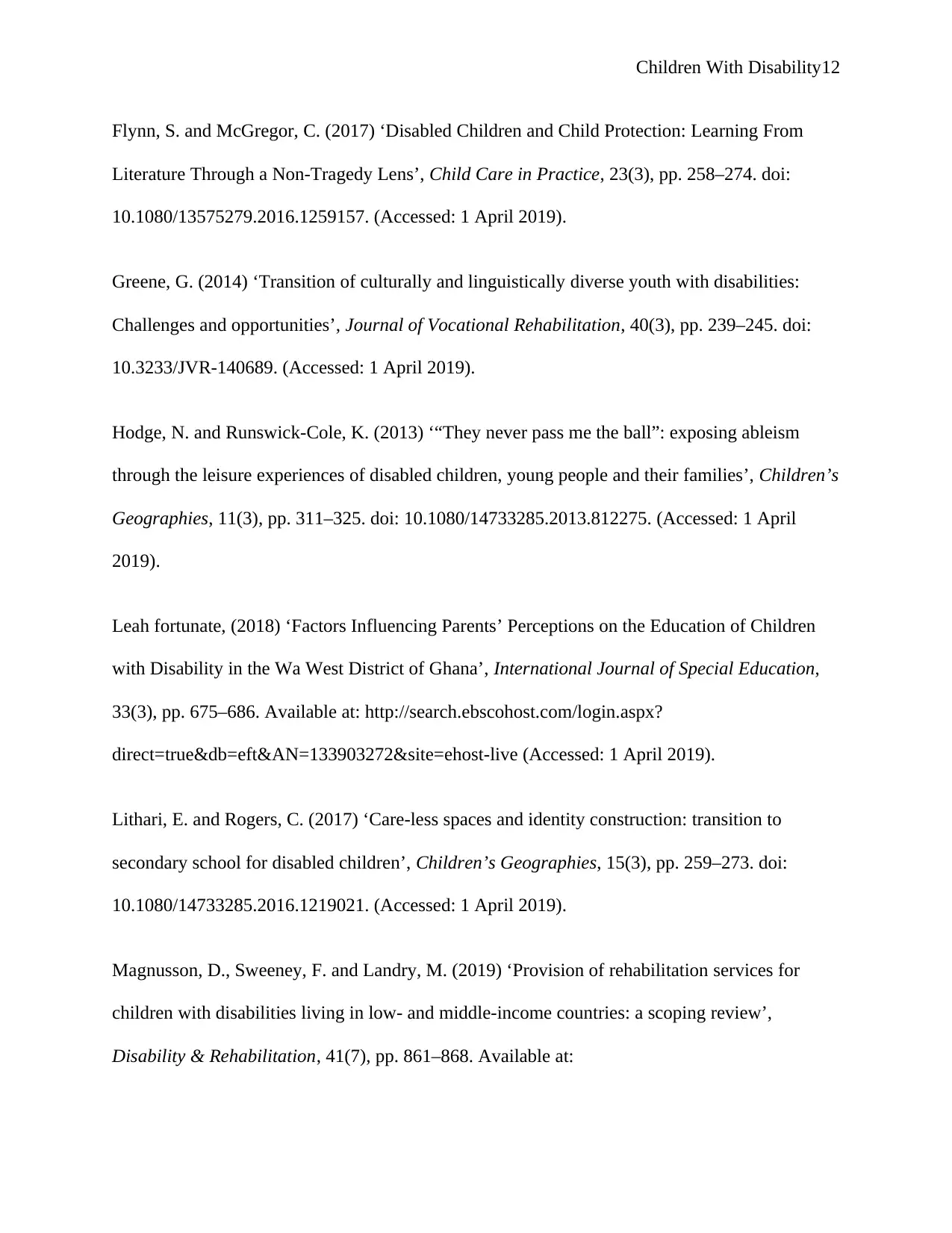
Children With Disability12
Flynn, S. and McGregor, C. (2017) ‘Disabled Children and Child Protection: Learning From
Literature Through a Non-Tragedy Lens’, Child Care in Practice, 23(3), pp. 258–274. doi:
10.1080/13575279.2016.1259157. (Accessed: 1 April 2019).
Greene, G. (2014) ‘Transition of culturally and linguistically diverse youth with disabilities:
Challenges and opportunities’, Journal of Vocational Rehabilitation, 40(3), pp. 239–245. doi:
10.3233/JVR-140689. (Accessed: 1 April 2019).
Hodge, N. and Runswick-Cole, K. (2013) ‘“They never pass me the ball”: exposing ableism
through the leisure experiences of disabled children, young people and their families’, Children’s
Geographies, 11(3), pp. 311–325. doi: 10.1080/14733285.2013.812275. (Accessed: 1 April
2019).
Leah fortunate, (2018) ‘Factors Influencing Parents’ Perceptions on the Education of Children
with Disability in the Wa West District of Ghana’, International Journal of Special Education,
33(3), pp. 675–686. Available at: http://search.ebscohost.com/login.aspx?
direct=true&db=eft&AN=133903272&site=ehost-live (Accessed: 1 April 2019).
Lithari, E. and Rogers, C. (2017) ‘Care-less spaces and identity construction: transition to
secondary school for disabled children’, Children’s Geographies, 15(3), pp. 259–273. doi:
10.1080/14733285.2016.1219021. (Accessed: 1 April 2019).
Magnusson, D., Sweeney, F. and Landry, M. (2019) ‘Provision of rehabilitation services for
children with disabilities living in low- and middle-income countries: a scoping review’,
Disability & Rehabilitation, 41(7), pp. 861–868. Available at:
Flynn, S. and McGregor, C. (2017) ‘Disabled Children and Child Protection: Learning From
Literature Through a Non-Tragedy Lens’, Child Care in Practice, 23(3), pp. 258–274. doi:
10.1080/13575279.2016.1259157. (Accessed: 1 April 2019).
Greene, G. (2014) ‘Transition of culturally and linguistically diverse youth with disabilities:
Challenges and opportunities’, Journal of Vocational Rehabilitation, 40(3), pp. 239–245. doi:
10.3233/JVR-140689. (Accessed: 1 April 2019).
Hodge, N. and Runswick-Cole, K. (2013) ‘“They never pass me the ball”: exposing ableism
through the leisure experiences of disabled children, young people and their families’, Children’s
Geographies, 11(3), pp. 311–325. doi: 10.1080/14733285.2013.812275. (Accessed: 1 April
2019).
Leah fortunate, (2018) ‘Factors Influencing Parents’ Perceptions on the Education of Children
with Disability in the Wa West District of Ghana’, International Journal of Special Education,
33(3), pp. 675–686. Available at: http://search.ebscohost.com/login.aspx?
direct=true&db=eft&AN=133903272&site=ehost-live (Accessed: 1 April 2019).
Lithari, E. and Rogers, C. (2017) ‘Care-less spaces and identity construction: transition to
secondary school for disabled children’, Children’s Geographies, 15(3), pp. 259–273. doi:
10.1080/14733285.2016.1219021. (Accessed: 1 April 2019).
Magnusson, D., Sweeney, F. and Landry, M. (2019) ‘Provision of rehabilitation services for
children with disabilities living in low- and middle-income countries: a scoping review’,
Disability & Rehabilitation, 41(7), pp. 861–868. Available at:
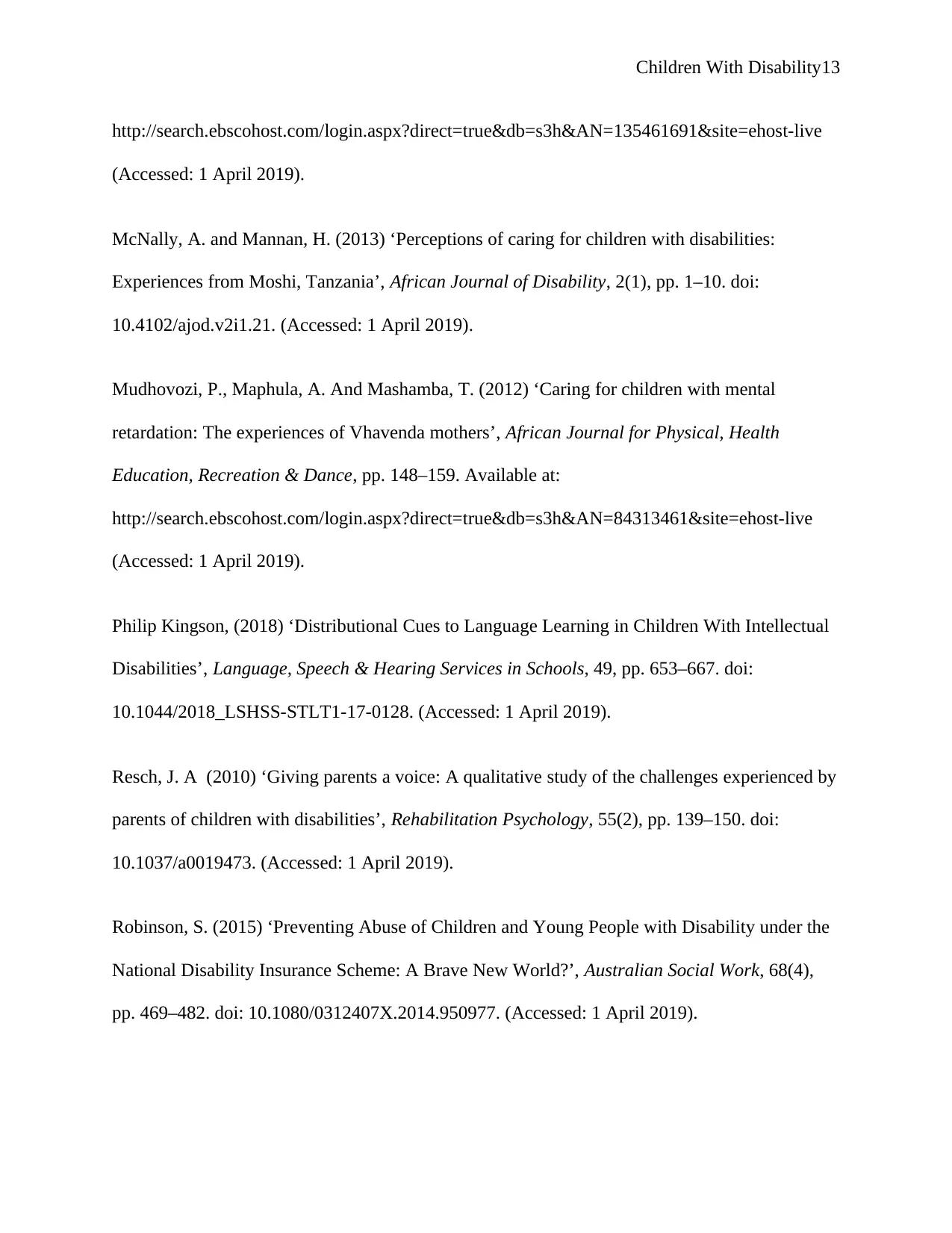
Children With Disability13
http://search.ebscohost.com/login.aspx?direct=true&db=s3h&AN=135461691&site=ehost-live
(Accessed: 1 April 2019).
McNally, A. and Mannan, H. (2013) ‘Perceptions of caring for children with disabilities:
Experiences from Moshi, Tanzania’, African Journal of Disability, 2(1), pp. 1–10. doi:
10.4102/ajod.v2i1.21. (Accessed: 1 April 2019).
Mudhovozi, P., Maphula, A. And Mashamba, T. (2012) ‘Caring for children with mental
retardation: The experiences of Vhavenda mothers’, African Journal for Physical, Health
Education, Recreation & Dance, pp. 148–159. Available at:
http://search.ebscohost.com/login.aspx?direct=true&db=s3h&AN=84313461&site=ehost-live
(Accessed: 1 April 2019).
Philip Kingson, (2018) ‘Distributional Cues to Language Learning in Children With Intellectual
Disabilities’, Language, Speech & Hearing Services in Schools, 49, pp. 653–667. doi:
10.1044/2018_LSHSS-STLT1-17-0128. (Accessed: 1 April 2019).
Resch, J. A (2010) ‘Giving parents a voice: A qualitative study of the challenges experienced by
parents of children with disabilities’, Rehabilitation Psychology, 55(2), pp. 139–150. doi:
10.1037/a0019473. (Accessed: 1 April 2019).
Robinson, S. (2015) ‘Preventing Abuse of Children and Young People with Disability under the
National Disability Insurance Scheme: A Brave New World?’, Australian Social Work, 68(4),
pp. 469–482. doi: 10.1080/0312407X.2014.950977. (Accessed: 1 April 2019).
http://search.ebscohost.com/login.aspx?direct=true&db=s3h&AN=135461691&site=ehost-live
(Accessed: 1 April 2019).
McNally, A. and Mannan, H. (2013) ‘Perceptions of caring for children with disabilities:
Experiences from Moshi, Tanzania’, African Journal of Disability, 2(1), pp. 1–10. doi:
10.4102/ajod.v2i1.21. (Accessed: 1 April 2019).
Mudhovozi, P., Maphula, A. And Mashamba, T. (2012) ‘Caring for children with mental
retardation: The experiences of Vhavenda mothers’, African Journal for Physical, Health
Education, Recreation & Dance, pp. 148–159. Available at:
http://search.ebscohost.com/login.aspx?direct=true&db=s3h&AN=84313461&site=ehost-live
(Accessed: 1 April 2019).
Philip Kingson, (2018) ‘Distributional Cues to Language Learning in Children With Intellectual
Disabilities’, Language, Speech & Hearing Services in Schools, 49, pp. 653–667. doi:
10.1044/2018_LSHSS-STLT1-17-0128. (Accessed: 1 April 2019).
Resch, J. A (2010) ‘Giving parents a voice: A qualitative study of the challenges experienced by
parents of children with disabilities’, Rehabilitation Psychology, 55(2), pp. 139–150. doi:
10.1037/a0019473. (Accessed: 1 April 2019).
Robinson, S. (2015) ‘Preventing Abuse of Children and Young People with Disability under the
National Disability Insurance Scheme: A Brave New World?’, Australian Social Work, 68(4),
pp. 469–482. doi: 10.1080/0312407X.2014.950977. (Accessed: 1 April 2019).
Paraphrase This Document
Need a fresh take? Get an instant paraphrase of this document with our AI Paraphraser

Children With Disability14
Seo Hee Lee et al. (2018) ‘Advocacy for Immigrant Parents of Children with Disabilities’,
Palaestra, 32(2), pp. 23–28. Available at: http://search.ebscohost.com/login.aspx?
direct=true&db=s3h&AN=130206299&site=ehost-live (Accessed: 1 April 2019).
Sharma, A., Dunay, A. And Dely, R. L. (2018) ‘Special Education Versus Inclusive Education:
Examining Concerns and Attitudes of Teaching Professionals toward Children with Disabilities’,
Forum Scientiae Oeconomia, 6(1), pp. 84–101. doi: 10.23762/FSO_VOL6NO1_18_5.
(Accessed: 1 April 2019).
Stephens, L (2017) ‘Inaccessible childhoods: evaluating accessibility in homes, schools and
neighbourhoods with disabled children’, Children’s Geographies, 15(5), pp. 583–599. doi:
10.1080/14733285.2017.1295133. (Accessed: 1 April 2019).
Zachary Lwalbety (2016) ‘Bringing Instructional Strategies Home’, Teaching Exceptional
Children, 48(3), pp. 159–167. doi: 10.1177/0040059915605816. (Accessed: 1 April 2019).
Seo Hee Lee et al. (2018) ‘Advocacy for Immigrant Parents of Children with Disabilities’,
Palaestra, 32(2), pp. 23–28. Available at: http://search.ebscohost.com/login.aspx?
direct=true&db=s3h&AN=130206299&site=ehost-live (Accessed: 1 April 2019).
Sharma, A., Dunay, A. And Dely, R. L. (2018) ‘Special Education Versus Inclusive Education:
Examining Concerns and Attitudes of Teaching Professionals toward Children with Disabilities’,
Forum Scientiae Oeconomia, 6(1), pp. 84–101. doi: 10.23762/FSO_VOL6NO1_18_5.
(Accessed: 1 April 2019).
Stephens, L (2017) ‘Inaccessible childhoods: evaluating accessibility in homes, schools and
neighbourhoods with disabled children’, Children’s Geographies, 15(5), pp. 583–599. doi:
10.1080/14733285.2017.1295133. (Accessed: 1 April 2019).
Zachary Lwalbety (2016) ‘Bringing Instructional Strategies Home’, Teaching Exceptional
Children, 48(3), pp. 159–167. doi: 10.1177/0040059915605816. (Accessed: 1 April 2019).
1 out of 14
Related Documents
Your All-in-One AI-Powered Toolkit for Academic Success.
+13062052269
info@desklib.com
Available 24*7 on WhatsApp / Email
![[object Object]](/_next/static/media/star-bottom.7253800d.svg)
Unlock your academic potential
© 2024 | Zucol Services PVT LTD | All rights reserved.





